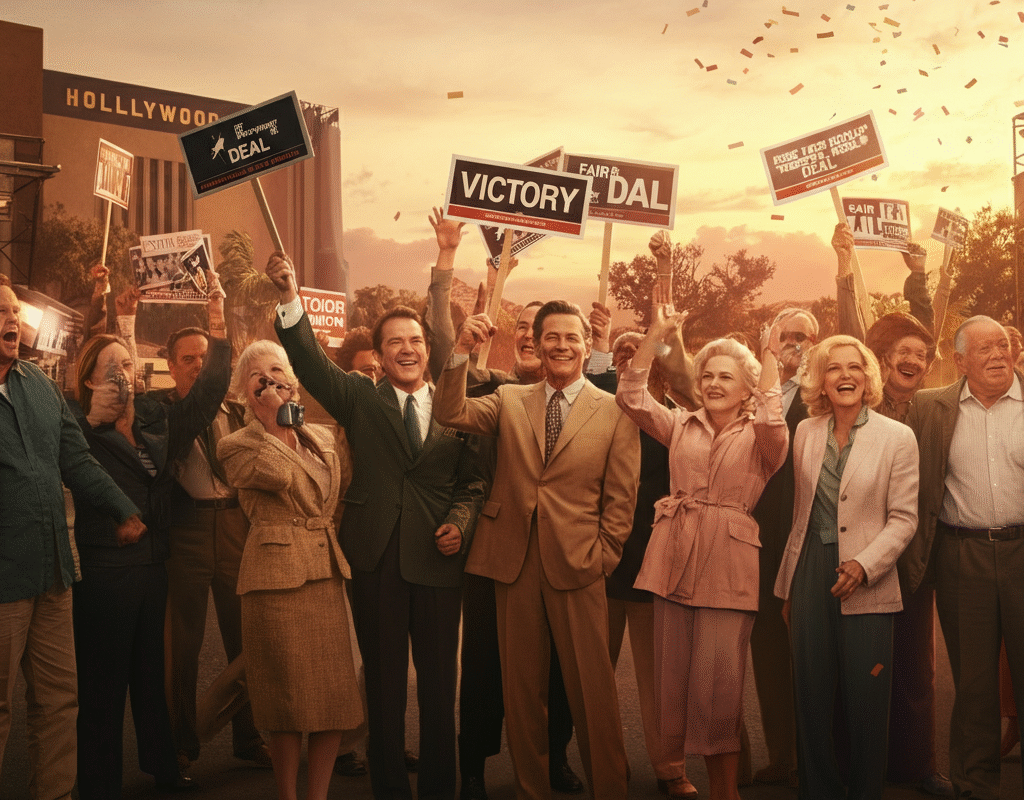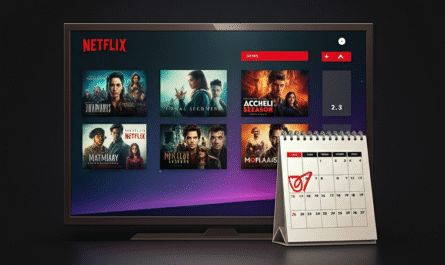After 118 grueling days, the entertainment world finally breathed a collective sigh of relief. The Hollywood actors union reaches deal after months-long strike, marking the end of one of the most significant work stoppages in entertainment history. This historic agreement between SAG-AFTRA and the Alliance of Motion Picture and Television Producers (AMPTP) brings hope to thousands of performers and productions that were left in limbo.
The strike, which began in July 2023, brought Hollywood to a near-complete standstill. From A-list celebrities to background actors, everyone stood united in demanding fair compensation and protection against artificial intelligence threats. Now that the Hollywood actors union reaches deal after months-long strike, the industry can finally move forward and heal from this unprecedented disruption.
What Led to the Historic Strike?
The Breaking Point
The strike didn’t happen overnight. Years of growing tensions between actors and studios finally reached a boiling point. Actors felt increasingly squeezed by streaming platforms that offered lower residual payments compared to traditional television and film distribution. The Hollywood actors union reaches deal after months-long strike only after these core issues were addressed comprehensively.
Key factors that triggered the strike included:
- Inadequate compensation for streaming content
- Lack of transparency in viewership data
- Growing concerns about AI replacing human performers
- Reduced residual payments from digital platforms
- Poor working conditions for background actors
The Role of Streaming Services
Streaming platforms fundamentally changed how content is consumed and monetized. Unlike traditional TV reruns or theatrical releases, streaming services often keep viewership numbers secret. This lack of transparency made it impossible for actors to negotiate fair residual payments based on a show’s success.
The entertainment landscape shifted dramatically over the past decade. Where actors once relied on steady residual checks from syndicated shows, streaming platforms offered minimal ongoing compensation. This disparity became a central issue when the Hollywood actors union reaches deal after months-long strike negotiations intensified.
Key Demands That Shaped the Negotiations
Fair Compensation in the Streaming Era
Actors demanded better pay structures that reflected the true value streaming content provides to platforms. The union argued that successful shows on Netflix, Amazon Prime, or Disney+ generate billions in subscriber revenue, yet actors saw little of this financial success.
Primary compensation demands included:
- Higher base pay rates for streaming productions
- Improved residual formulas based on success metrics
- Bonus payments for highly successful content
- Better compensation for background performers
- Transparency in streaming viewership data
Artificial Intelligence Protections
Perhaps no issue generated more concern than the potential misuse of artificial intelligence. Actors feared studios might use their likenesses without permission or fair compensation. The Hollywood actors union reaches deal after months-long strike only after securing robust AI protections that set industry precedents.
The union demanded clear consent requirements for digital recreation of actors’ voices, faces, and performances. They also sought ongoing compensation when studios use AI to replicate an actor’s work beyond the original performance.
The Strike’s Impact on Hollywood Productions
Immediate Production Shutdowns
When the Hollywood actors union reaches deal after months-long strike talks failed initially, productions ground to a halt. Major films and television shows faced indefinite delays. Studios lost millions daily while sets sat empty and crews remained unemployed.
High-profile projects affected included:
- Marvel Cinematic Universe films
- Major television series mid-season
- Award season campaigns and premieres
- International co-productions
- Independent film projects
Economic Ripple Effects
The strike’s impact extended far beyond actors and studios. Catering companies, equipment rental houses, post-production facilities, and countless other businesses felt the economic squeeze. Local economies in production hubs like Los Angeles, Atlanta, and New York suffered significant losses.
According to industry analysts, the strike cost the California economy alone over $5 billion. This staggering figure includes lost wages, reduced tax revenue, and decreased business for supporting industries. The Hollywood actors union reaches deal after months-long strike partly due to mounting pressure from these economic consequences.
Breaking Down the Final Agreement
Compensation Improvements
The deal includes substantial wins for performers across all experience levels. Minimum wage increases, improved residual formulas, and success-based bonuses address many longstanding concerns. The Hollywood actors union reaches deal after months-long strike with compensation improvements that exceed previous contracts by significant margins.
Key compensation changes include:
- 7% general wage increase in year one
- Additional 4% increases in years two and three
- New residual structure for streaming content
- Performance bonuses for successful shows
- Improved rates for background actors
AI Protection Measures
The agreement establishes groundbreaking protections against unauthorized AI use. Studios must obtain explicit consent before creating digital replicas of actors. Additionally, performers receive compensation when their AI likenesses are used in future projects.
These protections include strict guidelines for voice replication, facial recreation, and performance duplication. The Hollywood actors union reaches deal after months-long strike with AI safeguards that many consider industry-leading standards.
Comparing Pre-Strike vs. Post-Strike Conditions
|
Category |
Before Strike |
After Deal |
|---|---|---|
|
Minimum Daily Rate |
$1,082 |
$1,157 |
|
AI Consent Requirements |
Limited/Unclear |
Explicit Written Consent Required |
|
Streaming Residuals |
Minimal Fixed Amount |
Success-Based Formula |
|
Background Actor Pay |
$187/day |
$200/day |
|
Health Plan Contributions |
Existing Rate |
11% Increase |
|
Viewership Transparency |
None |
Quarterly Reports Required |
The Role of Celebrity Support
A-List Solidarity
When the Hollywood actors union reaches deal after months-long strike, it was partly due to unprecedented celebrity solidarity. Stars like Meryl Streep, George Clooney, and Jennifer Lawrence publicly supported striking actors and donated millions to hardship funds.
This celebrity backing provided both financial support and media attention that kept public pressure on studios. Unlike previous strikes, this one saw unified support across all performer categories, from leading actors to day players.
Social Media Campaigns
Celebrities leveraged their social media influence to educate the public about strike issues. Hashtags like #SAGAFTRAStrong and #ActorsOnStrike trended regularly, keeping the cause in public consciousness. This digital solidarity played a crucial role in maintaining momentum until the Hollywood actors union reaches deal after months-long strike.
International and Independent Production Effects
Global Production Delays
The strike’s impact reached far beyond Hollywood. International co-productions featuring American actors faced delays or cancellations. Film festivals postponed premieres, and distribution schedules required major adjustments worldwide.
European and Canadian productions particularly felt the impact, as many rely on American talent for international appeal. The Hollywood actors union reaches deal after months-long strike just in time to salvage several major international projects scheduled for 2024 releases.You can also read Popular Series Renewed for Final Season on Netflix.
Independent Film Challenges
Smaller productions faced unique hardships during the strike. Unlike major studios with deep pockets, independent filmmakers couldn’t absorb extended delays. Many indie projects lost financing or faced cancellation when the Hollywood actors union reaches deal after months-long strike took longer than expected.
The agreement includes special provisions for independent productions, recognizing their different financial constraints while maintaining core protections for performers.
Long-Term Industry Changes
Precedent for Future Negotiations
The deal establishes important precedents for how the industry handles emerging technologies and new distribution methods. Future contracts will likely build upon the AI protections and streaming compensation structures negotiated during this historic strike.
When the Hollywood actors union reaches deal after months-long strike, it created a framework that other entertainment unions worldwide will likely adopt. The agreement demonstrates that performers can successfully organize against technological disruption and corporate consolidation.
Streaming Platform Adaptations
Major streaming services must now adjust their business models to accommodate higher performer compensation and increased transparency requirements. This shift may influence subscription pricing, content budgets, and production strategies across the industry.
The new transparency requirements mean platforms can no longer hide behind proprietary viewership data when negotiating residuals. This change fundamentally alters the relationship between performers and streaming services.
What This Means for Audiences
Content Production Recovery
Now that the Hollywood actors union reaches deal after months-long strike, audiences can expect a gradual return to normal content production. However, the backlog of delayed projects means some shows and films may not return to screens for months.
Timeline expectations for content return:
- Immediate: Talk shows and unscripted content
- 2-4 weeks: Existing series production resumes
- 2-3 months: New series begin production
- 6-12 months: Delayed films reach theaters
- 12+ months: Strike’s full impact on release schedules resolves
Quality and Innovation
The deal’s emphasis on fair compensation may lead to higher-quality content as talented performers feel more valued and secure. Additionally, AI protection measures ensure that human creativity remains central to entertainment production.
According to insights from forbiez.co.uk Blog, the strike’s resolution may spark a new era of creative collaboration between performers and studios, potentially leading to more innovative storytelling approaches.
Key Takeaways
- Historic Resolution: The Hollywood actors union reaches deal after months-long strike, ending one of entertainment’s longest work stoppages
- Significant Gains: Actors secured substantial pay increases, AI protections, and improved streaming residuals
- Industry Precedent: The agreement sets new standards for how entertainment handles technological disruption
- Economic Recovery: Hollywood can now begin recovering from billions in lost revenue and delayed productions
- Future Impact: The deal influences how future contracts address emerging technologies and distribution methods
Frequently Asked Questions
When did the Hollywood actors union reach the deal after the months-long strike?
The Hollywood actors union reaches deal after months-long strike was officially announced in November 2023, ending the 118-day work stoppage that began in July.
What were the main reasons for the strike?
The strike centered on fair compensation for streaming content, AI protection measures, improved working conditions, and greater transparency in viewership data from streaming platforms.
How will this affect upcoming movies and TV shows?
While production has resumed, audiences should expect delays in content releases due to the extended shutdown. Some projects may be postponed by 6-12 months from their original schedules.
What are the new AI protections for actors?
The deal requires explicit written consent before using actors’ AI likenesses and provides ongoing compensation for digital replications of their performances.
How much did actors’ pay increase?
The agreement includes a 7% wage increase in the first year, followed by 4% increases in subsequent years, along with improved residual payments for streaming content.
Will this deal affect international productions?
Yes, international co-productions featuring American union actors must comply with the new agreement terms, potentially affecting budgets and production schedules globally.
Conclusion
The resolution of this historic dispute marks a turning point for the entertainment industry. When the Hollywood actors union reaches deal after months-long strike, it demonstrated that collective action can successfully address technological disruption and corporate consolidation in the digital age.
This agreement doesn’t just benefit actors—it establishes principles that protect creative professionals across all industries facing similar challenges. The deal’s emphasis on fair compensation, technological protections, and transparency creates a blueprint for navigating future workplace disruptions.
As Hollywood moves forward, the lessons learned from this strike will influence labor relations for years to come. The entertainment industry now has a framework for addressing emerging technologies while ensuring that human creativity and talent remain properly valued and compensated.
The successful resolution proves that when workers unite around clear principles and maintain solidarity across all levels, meaningful change is possible even against powerful corporate interests. The Hollywood actors union reaches deal after months-long strike will be remembered as a pivotal moment when the entertainment industry chose to protect its most valuable asset: the talented people who bring stories to life.




